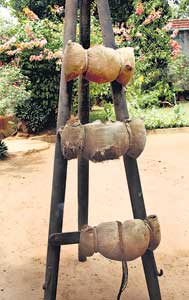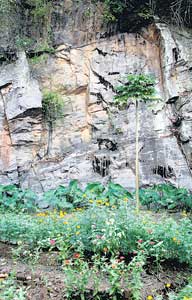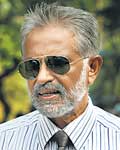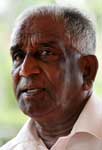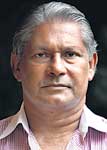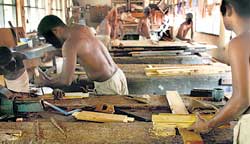
Empire making was hard labourMahara prison was once notorious for its hard labour and harsh punishments. A sheer rock face with borings or holes, a stark reminder of times gone by when hard labour was extracted from human beings. Seeing the bustling activity in a large area scattered with plots sporting pathola and other vegetables, carpentry and coir workshops, smithy, weaving centre with clacking handloom, piggery with its very own odour, et al now sandwiched between a beautifully greened playground and the huge rock, one can only imagine what life must have been in the 1800s for those incarcerated at the Mahara prison.
"The British kept the prisoners here to quarry metal day in and day out to build the breakwater at the harbour," says Mahara Superintendent of Prisons, Gamini Kulatunga pointing out the tank from where the steam-engine trains, used for the transportation of the metal, would have filled up on water. Parts of the long-dismantled railtracks are also around. The Mahara quarry would have been the reason why the British set up the prison, the third largest in the country, next to Welikada and Bogambara, way back in 1875. Quarrying of the rock would have taken place after the holes bored into it were filled with dynamite and then lit to shatter the rock, after which the prisoners would physically hammer down the rockfall to make them into manageable sizes. Not only did they quarry the rock here but also at the Port Commission quarry a distance away. Ultimately, hard labour in the form of crushing stones or husk-beating had been abolished under sweeping prison reforms. Vestiges of the colonial prison system and how prisoner indiscipline was dealt with, some measures which continued into the 1970s, long after the British had left Sri Lanka's shores, can still be seen at Mahara. Whipping was the order of the day, says Mr. Kulatunga, pointing to a whip displayed in a glass cupboard in his office, the number of cuts depending on the gravity of the offence of indiscipline committed. Indiscipline covers a large number of offences under Section 78 of the Prison Ordinance including violation of prison rules and regulations, mutiny, inciting other prisoners, assault or use of a weapon on the staff or other prisoners, jailbreak……the list goes on.
He remembers vividly, though it was at Welikada, the whipping of Nugegoda's infamous gang leader Noel Amerasinghe in the late 1970s, for assaulting a prison officer and attempting a jail-break. The lashes would either be on the back or the buttocks with the prisoner being asked to tightly embrace a padded timber stand. The officers who handled this task were especially trained in its art by practising on dummies. "Pattar gala the skin splits open as the whip makes contact," says Mr. Kulatunga and even the most tough-talking prisoner will scream in agony. Soft-spoken Mr. Kulatunga, however, believes that segregation from society as opposed to corporal punishment would be the answer even in the case of notorious offenders. Now whipping is no more and if the offence within the prison is very serious, the prisoner can be sent before a tribunal chaired by the District Judge of the area and given a punishment of five additional years of imprisonment. Some "big names" on the crime scene down the ages have called Mahara "home". The "crime of the time", when violence was not rampant as it is now, recalled by prison officers who have served at Mahara, is the heist of nine lakhs by a gang of armed robbers who blocked the old Victoria bridge with a vehicle and robbed a CWE vehicle. However, the cash they had looted had been quite small because there had been many cheques. It was in the 1960s and the villains sent to Mahara in this connection were Sirisena alias Cheena, Pichchichcha Dharme, Cutex Piyadasa and Harischandra. Island Reconvicted Criminal (IRC) 881/47 Sanchi Aratchige Jinadasa alias Yakadaya who haunted the Anuradhapura area in the 1950s and in cold blood, shot dead the Maradankadawela Postmaster at point blank range for a few hundred rupees, was also jailed at Mahara. Another armed robber duo Francis Fernando alias Nava Riyan (named so because of his height) and Piyathilaka Perera, Gampaha Munidasa, boxer-turned-street fighter who was in there for murder and robbery, Kaba Anthony also convicted of murder and robbery and Selladorai who had stolen a Buddha statue made of gold from the Werahena temple in Matara have all been here. Incarceration had not deterred some hardened criminals from continuing their lifestyles, as the various kinds of weapons, some crudely fashioned but others more sophisticated, exhibited in the SP's office stand testimony.
"A red badge worn on the white jumper which was part of the prison wear indicated 'dangerous criminals' those days and helped officers to identify them at a glance," explains Frank Abeypala, 75, who joined the prison service as a tender youth of 17 and served at Mahara for 19 years at different times. This was when both petty and hardcore criminals were kept together. The last time he left Mahara, Mr. Abeypala, a well-known sportsman in the service, had earned "three stripes and a crown" (the rank of Head Overseer now known as Staff Sergeant). If there was any riot or trouble in the prison, the first prisoners to be isolated were the red badges, he says, reliving the day when a prisoner working in the coir section approached the Chief Jailor in the early 1950s, C.M. Cottelingam, on the pretext of complaining about something and slashed at him with a sharp tool, like a sword, used to shave off excess coir from some products. "Luckily the blow caught Cottelingam on the huge metal buckle which holds the belt together," smiles Mr. Abeypala. He remembers Yakadaya, who had been kept in isolation and was rearing cats and pigeons in the empty cell next to his. Incidentally, the most secure and isolated area in the Left Division of the Mahara prison is dubbed Rathu Cheene (Red China) and sometimes prisoners proudly claim they are from that section to spread fear among the others and also gain misplaced prestige, The Sunday Times understands. Why Red China? "The name came about when China was conducting its affairs in isolation," says SP Kulatunga, stressing that whatever happens in society, outside the walls of the prison, is reflected within as well. Riots that rocked the prison Remanded for shooting dead a Mahara prisoner but later freed on grounds that it was "justifiable homicide not amounting to murder", Upali Dharmabandu, 65, who had retired as Senior Prisons Commissioner (Administration) talks of his chequered career and September 20, 1969 as if it were yesterday. Just recruited to the service as a jailor, he was off-duty around 10 in the morning on that memorable day, when he heard there was trouble. Earlier, the Acting Chief Jailor Tillekeratne had dealt a couple of slaps to a prisoner for a misdeed and locked him up in the special section. Foolishly, when news filtered through that some prisoners in the special section were planning an escape, not suspecting a trap, the Actg. Chief Jailor had gone there.
"The prisoners assaulted him and grabbed the keys," says Mr. Dharmabandu, and he died on the way to the hospital. That was the start of a "big riot", hearing of which, Mr. Dharmabandu rushed in, opened the "gun cupboard" grabbed a gun and shot at the prisoners. The man he dropped was Harischandra, a convict in the CWE nine-lakh armed robbery, who was up on the roof of the special D section using tiles as missiles on the staff below. "I was remanded for about eight days at the Magazine Prison in Welikada after a big inquiry but later freed," says Mr. Dharmabandu, laughingly adding that he has been both a prison officer and prisoner. 1969 was also not the first riot experienced at Mahara. In fact, the walls within the walls of Mahara demarcating 'Rathu Cheene' and placing dangerous criminals there had been erected after the riot of 1953. "Remember the famous leftist hartal. Around the same time there was rioting at Mahara," says Mr. Frank Abeypala who was there at that time. The rioters had chased away the prison officers who were unarmed and overrun the prison, with the riot being quelled only when the army was called in and four prisoners shot dead. Even during the time of the British, in 1900, a riot had taken place at the Mahara quarry, records indicate, after which the "entire Sinhalese staff was removed and were replaced by Malay staff". Unique prison Mahara is unique among the large prisons in the country, for there is no death row, as condemned prisoners are not kept here and neither is there a women's section. There are 'lifers', those sentenced to life imprisonment, and also 'special' non-convicted remand prisoners such as gang leaders, says SP Gamini Kulatunga, hastening to explain that they are not given any special treatment but fall into this category because of the offences committed.
Mahara sprawled across 48 acres, demarcated into the Right and Left Divisions, had on its roll-call 1,139 convicted, 730 non-convicted and 4 who have appealed against their sentences, on Wednesday when The Sunday Times visited. It is mainly for re-reconvicted prisoners (three or more times or many-time offenders) who have been sentenced to more than six months, and some remand prisoners sent from the Magistrates' Courts of Wattala, Gampaha, Attanagalle and Pugoda. This, among all prisons around the country, is the only one with its very own police station, from the very inception. The police unit stationed here provides escorts and protection. From the Right Division, 'prisoner parties' are detailed to work in the quarry area or the industrial section outside prison walls while those in the Left Division are not allowed out of the maximum-secured area. They work in an industrial section within the Left Division itself. Only the short termers, those sentenced to less than five years, are taken to the quarry area. The large grounds of Mahara, the upkeep of which is the responsibility of the prisoners, is used not only by athletes but also busloads of schoolchildren for sports practice. |
|
||||||
|| Front
Page | News | Editorial | Columns | Sports | Plus | Financial
Times | International | Mirror | TV
Times | Funday
Times || |
| |
Reproduction of articles permitted when used without any alterations to contents and a link to the source page.
|
© Copyright
2008 | Wijeya
Newspapers Ltd.Colombo. Sri Lanka. All Rights Reserved. |

